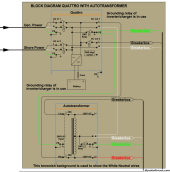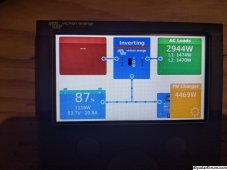WolfbaneAries
New Member
- Joined
- Sep 10, 2022
- Messages
- 49
Currently I am running 2 Multiplus II 48/3000/35s in split phase configuration. My problem is that despite my efforts to balance the loads in the breaker box, at times enough power is drawn on one leg to put the respective multiplus into overload while the other multi is just sitting there.
In order to solve this problem I'm looking at using an Autotransformer to balance the loads. My question is about how to configure this setup keeping in mind that I would like to stack additional multiplus units down the road for more power output. Should I:
A: Keep the two multiplus units in parallel split phase configuration and use the autotransformer for load balancing, then down the road add two additional multiplus into the configuration or
B: Reconfigure the multis to series single phase configuration feeding ~6kVA 120v to the autotransformer which in turn provides the 240v split phase, then down the road add an additional multi or two to provide more 120v power to the autotransformer?
The advantages I see for option B are that 1: I can add just one Multiplus into the system to increase my total available power rather than needing to purchase two at a time and 2: both multis can provide 35a of charging to the batteries if/when I need to run the generator, but I'm curious to know other's thoughts.
In order to solve this problem I'm looking at using an Autotransformer to balance the loads. My question is about how to configure this setup keeping in mind that I would like to stack additional multiplus units down the road for more power output. Should I:
A: Keep the two multiplus units in parallel split phase configuration and use the autotransformer for load balancing, then down the road add two additional multiplus into the configuration or
B: Reconfigure the multis to series single phase configuration feeding ~6kVA 120v to the autotransformer which in turn provides the 240v split phase, then down the road add an additional multi or two to provide more 120v power to the autotransformer?
The advantages I see for option B are that 1: I can add just one Multiplus into the system to increase my total available power rather than needing to purchase two at a time and 2: both multis can provide 35a of charging to the batteries if/when I need to run the generator, but I'm curious to know other's thoughts.







